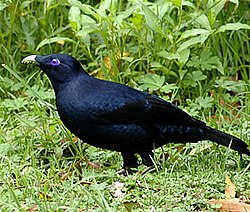Bowerbird
| Bowerbirds | |
|---|---|

| |
| Male satin bowerbird Ptilonorhynchus violaceus | |
| Scientific classification | |
| Kingdom: | |
| Phylum: | |
| Class: | |
| Order: | |
| Suborder: | |
| Family: | Ptilonorhynchidae
|

Bowerbirds are the bird family Ptilonorhynchidae. The family has 20 species in eight genera. Bowerbirds are most known for their unique courtship behaviour. Males build a structure and decorate it with sticks and brightly coloured objects. The Vogelkop bowerbird is a good example. The function of this courtship ritual is to attract a mate. The bowerbirds have a "female choice" mating system.
The bowerbirds have an Austro-Papuan distribution, with ten species endemic in New Guinea, eight endemic to Australia and two found in both large islands.[1] Their distribution is mainly in the tropical parts of New Guinea and northern Australia, though some species extend into central, western and southeastern Australia. They occupy a range of different habitats, including rainforest, eucalyptus and acacia forest, and shrublands.
The birds are medium to large-sized passerines, ranging from the golden bowerbird at 22 centimetres (8.7 in) and 70 grams (2.5 oz) to the great bowerbird at 40 centimetres (16 in) and 230 grams (8.1 oz). Their diet consists mainly of fruit but may also include insects (especially for nestlings), flowers, nectar and leaves in some species.[2] The satin and spotted bowerbirds are sometimes regarded as pests because they feed on introduced fruit and vegetable crops.[3][4] They have occasionally been killed by affected farmers.[4]
References[change | change source]
- ↑ Rowland, Peter (2008). Bowerbirds. Australian Natural History Series. Collingwood: CSIRO Publishing. pp. 1–26. ISBN 978-0-643-09420-8.
- ↑ Frith, Clifford B. 1991. In Forshaw J. (ed) Encyclopedia of animals: Birds. London: Merehurst Press, 228–331. ISBN 1-85391-186-0
- ↑ Problem Wildlife
- ↑ 4.0 4.1 spotted bowerbird
